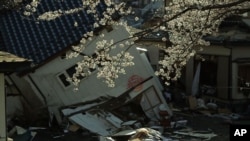A new film by British filmmaker Lucy Walker documents the powerful earthquake and tsunami that ravaged Japan’s northeastern coast a year ago.
"The Tsunami and the Cherry Blossom" opens with a powerful image - a single long shot from the top of a hill as a town is swept away in a rolling wave of blackened water.
Below, people react to the horror.
“It can’t be,” shouts one. A child cries, “Grandma! Dad, where is Grandma?” Other voice screams, “Get up here quick!” Someone then moans, “They aren’t going to make it.”
Walker films survivors in refugee centers as they sort through the rubble and reflect on their lives.
“The film takes you on a journey from the very initial stages of grief and shock and tells the story of how these amazingly courageous people manage to pick themselves up and carry on," Walker says. "What is that process? What is that journey that human beings can go on from being so struck back to being able to clean up and get along and continue on into a future despite having lost so much?”
Walker talks to one man who watched his best friend drown right in front of him because he had gone back to move his new car.
“He speaks very passionately about how he doesn’t want clothes, a house or anything. He just wants his friend back. He says, ‘I have nothing. I have nothing. I have nothing.’ And then, by the end, he says, ‘No. No. I’m going to revive.’ And you can tell he’s digging deeply enough to get the courage and it’s very inspiring actually to see how resilient human beings can be.”
In Japan, that resilience, that capacity for rebirth, is symbolized by the cherry blossom. The cultural icon appears everywhere, adorning holiday events, schools trips and wedding parties. The film shows cherry blossoms in bloom against a rubble-strewn landscape.
“In this very brief, very beautiful season, there’s a lot of spiritual feeling about it," Walker says. "There’s emotional healing power of the cherry blossom, not only is it spring and renewal, although that’s wonderful energy, but there’s something about how quickly and beautifully they come to life.”
Walker sees her film as a visual haiku, a kind of Japanese poem about life, death and how to live with tragedy.
“And so it is a poem about surviving and how beautiful life is," she says. "Somehow these cherry blossoms are sublimely, exquisitely, kind of uniquely beautiful and fleeting and that has a lot to teach us about life.”
"The Tsunami and the Cherry Blossom" ends with a message of hope. Walker meets a young woman on the same hilltop from the film’s opening sequence. She is taking pictures to document the change she's seen in the year since the disaster.
“Every year that the trees bloom, they will give us courage to keep going," says the young woman. "They blossom as they watch over this town. They saw the tsunami. They see everything. I want to tell the bloom, 'Keep watching us. We’ll revive.'”
MORE: Interview with Lucy Walker, director of "The Tsunami and the Cherry Blossom"








